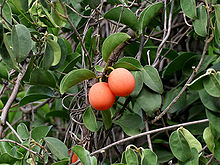| Ximenia americana | |
|---|---|

| |
| Scientific classification | |
| Kingdom: | Plantae |
| Clade: | Tracheophytes |
| Clade: | Angiosperms |
| Clade: | Eudicots |
| Order: | Santalales |
| Family: | Olacaceae |
| Genus: | Ximenia |
| Species: | X. americana
|
| Binomial name | |
| Ximenia americana | |

| |
| Range of X. americana throughout the world (in green) | |
| Synonyms[2] | |
|
List
| |
Ximenia americana, commonly known as tallow wood,[3] hog plum, yellow plum, sea lemon, or pi'ut (Chamorro),[4] is bush-forming shrub/small tree; a species from the Ximenia genus in the Olacaceae family.[2] It is mainly found in the tropics, ranging from Africa, India and southeast Asia, to Australia, New Zealand, Pacific Islands, West Indies, Central, North and South America.[5][6] It is especially common in Africa and South America.[7] It is not domesticated so it is only found occurring in the wild.
They grow in areas with more than 500 mm of mean annual rainfall and up to heights of 2000 m. It is commonly found in a variety of diverse habitats ranging from dry woodlands, hilly areas to coastal bushlands, along riverbanks, and mangroves[8] They are commonly found in poor and dry soil types. The plant has not been domesticated, so it only occurs in the wild.[5]
- ^ Cite error: The named reference
iucnwas invoked but never defined (see the help page). - ^ a b "Ximenia americana L." Plants of the World Online. Royal Botanic Gardens, Kew. Retrieved 1 June 2021.
- ^ USDA, NRCS (n.d.). "Ximenia americana". The PLANTS Database (plants.usda.gov). Greensboro, North Carolina: National Plant Data Team. Retrieved 7 August 2015.
- ^ Raulerson, L; Rinehart, A.F. (1992). Trees and shrubs of the Northern Mariana Islands. Commonwealth of the Northern Mariana Islands: Coastal Resources Management.
- ^ a b Cite error: The named reference
:3was invoked but never defined (see the help page). - ^ Lompo, Ounyambila; Dimobe, Kangbéni; Mbayngone, Elisée; Savadogo, Salfo; Sambaré, Oumarou; Thiombiano, Adjima; Ouédraogo, Amadé (June 2021). "Climate influence on the distribution of the yellow plum (Ximenia Americana L.) in Burkina Faso". Trees, Forests and People. 4: 100072. Bibcode:2021TFP.....400072L. doi:10.1016/j.tfp.2021.100072. ISSN 2666-7193.
- ^ Cite error: The named reference
:1was invoked but never defined (see the help page). - ^ Tan, Ria (13 January 2023). "Bedara laut (Ximenia americana)". Wild Singapore. Retrieved 2 June 2021.
